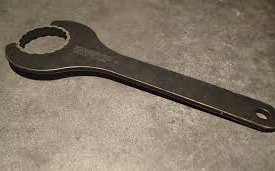
EDITORIAL
A Perplexing Piece Of Plastic
Let’s travel back in time to the simpler days of 2003. Imagine, if you will, that 99.9% of riders are ripping around on 26″ wheels, 135mm rear ends, 1-1/8″ steerer tubes, and running front derailleurs. Companies have adopted disk brakes en masse, tire compounds and tread patterns are starting to really work, crazy geometry experiments are differentiating trail bikes from XC race machines, and yearly improvements in the chassis and damping of suspension products have many a rider excited about what is to come.
That was when a bottom bracket was just a bottom bracket. With a few rare exceptions in European road bikes, you just needed to know if your frame had a 68mm or 73mm shell. Sometimes spacers included in the box meant you didn’t even need to know that.
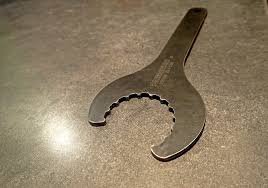
There aren’t many specialty tools from ten years ago that are still useful on a modern mountain bike. Behold the Shimano TL-FC32
I purchased one of the first 2004 model year Shimano M760 Hollowtech II XT cranksets in Canada. As with many riders, I had switched from the issues of ovalized crankarm interfaces and broken axles that square taper offered to the lacklustre, and sometimes miserable, bearing life of ISIS and Octalink. This crankset and bottom bracket offered a huge leap forward in survivability and, cosmetics aside, remained essentially unchanged until the release of Shimano M8000 this year. I opened the box, installed an eNVy bashring in place of the Shimano big ring, and pulled out the included bottom bracket wrench to start my swap.
External bottom brackets were in and Shimano had set the standard. RaceFace, Truvativ (SRAM), FSA, everyone’s external bottom brackets that were compatible with the Shimano installation tool. That same, Japanese made, Shimano TL-FC32 bottom bracket wrench that lives in my tool box today.
Now we have a tonne of pressfit bottom bracket systems, but the classic threaded (BSA) shell continues to stick around in steel, aluminum, and even bonded into some carbon frames. The use of 30mm spindles by some companies, like RaceFace’s Cinch models, has necessitated new interfaces and tools, but if you have a 24mm or smaller axle on your crankset, whether it be Shimano, RaceFace, SRAM (Howitzer or GXP), FSA or other, chances are my trusty old TL-FC32 will work. But wait. That’s no longer true? What company would bother, conceive, (dare?) to drop one of the last real ‘standards’ in the industry?
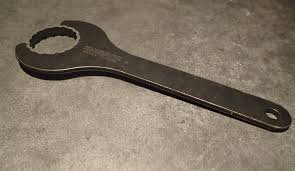
At least it’s backward compatible.
More than a decade after the TL-FC32 tool was released, I am holding a chunk of soft plastic. Its unassuming name; SHIMANO TL-FC25, is stamped on one side. On the other; Fit TL-FC32. It represents a perplexing ~4mm reduction in the outside diameter of the external BB cup on some Shimano bottom brackets.
Why? Shimano is not a company known for introducing new standards without good reason. Witness their pedal cleats that, with one exception, are backwards compatible to the first SPD pedals, and the cassette mounting standard they continue to work around as they add cogs to our drivetrains. Other less popular standards, like Centerlock rotors are an affront to widely adopted standards but sound performance-related reasoning has led to their adoption, or at least support, by other big industry players like DT Swiss.
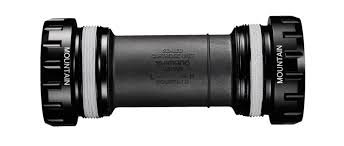
One of the offending bottom brackets: a Shimano MT800.
Shimano claims that the new bottom bracket “reduces weight and bearing drag while improving mud durability”, but any improvement to bearing performance or sealing could have easily been accomplished within the larger dimension they previously established. How much weight is saved by dropping ~4mm of diameter?
Thankfully new Shimano cranksets are fully compatible with previous external bottom brackets, and, yes, your M8000 and M9000 crankset will definitely work with your five year old Chris King bottom bracket, and your old crankset definitely works with the new BBs, so maybe it is all much ado about nothing?
Or maybe, in an industry where new standards seem to arrive daily, it is another perplexing piece of plastic for another underwhelming few millimetres of change.
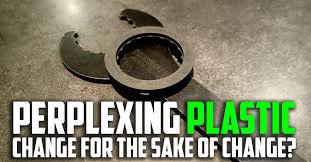
Can there be another reason for this change?







Comments
Stu
8 years, 1 month ago
I would almost forgive Shimano for shrinking the cup size, if they hadn't made two very slightly different new sizes for road and mountain. I'll still take them over PF of course.
Reply
AJ
8 years, 1 month ago
Bicycles are the future, cars are fast becoming old hat, with the demise of automobiles bikes will rule the roads. Do parts from ur fiesta fit a golf? No, u have to get the specific parts, the bike industry needs to survive so parts are designed not to last forever , all these new standards are just to keep the wheel turning, nothing about better, new n different to keep u spending!!!
Reply
ZigaK
8 years, 1 month ago
I think that the 2mm difference makes a noticeable difference in the size of the bearings that can fit in the cup.
Reply
DrewM
8 years, 1 month ago
Its an ~4mm smaller outside diameter, so if Shimano used the same architecture in building the new MT800 BBs as the older gen HTII BBs the bearings would have a smaller OD and the same ID so a smaller sized bearing in general.
I haven't pulled one apart, but from what Shimano is saying re. improved sealing it is likely constructed very differently from their past BBs, so that in itself may not be an issue (they are claiming improved durability).
Reply
Luix
8 years, 1 month ago
What I really want to know is if they hace started using bearings with seals on both sides. Shimano BBs and wet weather didn't go so well together because of that stupid bearing choice.
Reply
tashi
8 years, 1 month ago
Wouldn't making it smaller help with chainring/crankswingarm clearance for some bikes?
Reply
DrewM
8 years, 1 month ago
Look at the size difference between the tools in the photo. The new BB is ~2mm smaller in any radius. There's just no way that's a change for clearance.
If that tiny, tiny difference was intended for swing arm/linkage clearance then no BSA + 30mm application (E.G. Cinch) would work with the frame that required this BB.
Not to mention you still need to get the significantly larger diameter tool over the BB to remove it.
Reply
Andy Eunson
8 years, 1 month ago
Yeah. That sounds goofy. The reasons given sound like excuses not sound reasoning.
Reply
DrewM
8 years, 1 month ago
One benefit I failed to account for, and the general consensus in FaceBook land, is that the new BBs look much better…
It's inspired me into thinking about a follow up article about the cost of cosmetic changes called "You can't like the look of internal cable routing and whine that bikes are too expensive" (working title obviously).
Reply
tashi
8 years, 1 month ago
Internal cable routing sux for basically everything but looks. "Stealth" seatposts in particular (although there is a very good argument for cables that don't move WRT seatposts). Give me split cable stops for my shifting and external zap-tie mounts for everything else thankyouverymuch.
Reply
Andy Eunson
8 years, 1 month ago
Your sarcasm isn't coming through Drew.
Reply
Luix
8 years, 1 month ago
I have an alternate title for you: "B-b-but it's Teh Carbonz!"
Reply
DrewM
8 years, 1 month ago
Yeah I know… when you're this £#%€ing happy-go-lucky the sarcasm just doesn't come naturally.
Reply
t.odd
8 years, 1 month ago
YES YES YES
Reply
Kyle
8 years, 1 month ago
That little piece of crap rounds out after 5 or 10 installs too. Worthless in a shop setting. UGH. I hate 8000 based on this alone even though I think it stomps on XX1 style rear derailleurs.
Reply
DrewM
8 years, 1 month ago
One has to assume that the plastic reducer is just a stop gap until a new shop-quality tool is released? Don't they?
Calling Abbey Bike Tools!
Reply
Kyle
8 years, 1 month ago
It has been a year already. I'm tired of all the new crap and looking for a new job instead.
Reply
Cizzle
8 years, 1 month ago
You can get parktool aluminum one. it's been out for sometime now.
Reply
Rob Gretchen
8 years, 1 month ago
Blasphemy I say…. However, something from Abbey will make all the grumpy mechanics out there feel better.
Reply
Please log in to leave a comment.